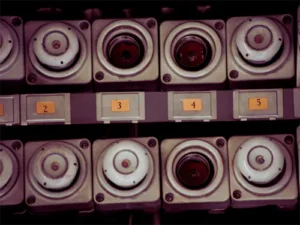 Fuse boxes used to be the best way to manage home electrical systems. However, they are now outdated. Modern appliances need more power than they can provide.
Fuse boxes used to be the best way to manage home electrical systems. However, they are now outdated. Modern appliances need more power than they can provide.
Unlike fuse boxes, which use thin metal wires that burn out to stop electricity, breaker boxes trip automatically. This helps prevent damage and makes them safer and easier to use.
Upgrading to a breaker box reduces the risk of fire, accommodates higher electrical loads, and provides long-term safety for your home. However, this is not a DIY job, it involves working with live wires, which can be hazardous without the proper skills.
In this guide, we’ll outline the process of switching a fuse box to a breaker box and explain why it’s a task best left to professionals.
Key Takeaways
- Learn why breaker boxes are safer and more efficient than fuse boxes.
- Understand how fuse boxes work and common reasons for blown fuses.
- Explore the step-by-step process of switching to a breaker box.
- Discover the advantages of hiring a professional for this upgrade.
How Fuses Work
 Understanding how fuses function can help you see why they’re outdated. Fuses protect your home’s electrical circuits by breaking the current flow when issues arise. Inside each fuse is a thin metal filament that melts (or “blows”) if the current exceeds safe limits.
Understanding how fuses function can help you see why they’re outdated. Fuses protect your home’s electrical circuits by breaking the current flow when issues arise. Inside each fuse is a thin metal filament that melts (or “blows”) if the current exceeds safe limits.
This stops electricity from overheating wires and causing a fire. Though effective in their time, fuses require manual replacement and don’t match the convenience of circuit breakers.
Common Reasons for Blown Fuses
Blown fuses are a sign of an issue in your home’s electrical system. Below are the most common causes and how they impact your circuits.
Electrical Overload
Older fuse boxes weren’t designed for today’s energy demands. Plugging in too many devices—like a hair dryer, toaster, and space heater—on one circuit can overload the system and blow a fuse.
Faulty Appliances
Appliances with loose wiring or bad connections create imbalances that cause fuses to blow. You can identify faulty appliances by unplugging devices one at a time and testing the circuit.
Short Circuit
Short circuits happen when hot wires touch neutral or ground wires, creating dangerous electrical surges. These can damage appliances, trip breakers, and even start fires.
How to Switch a Fuse Box to a Breaker Box: Step-by-Step Guide
 Switching to a breaker box is a detailed process that ensures your home is safer and meets modern electrical needs. Here’s an overview of the key steps professionals take.
Switching to a breaker box is a detailed process that ensures your home is safer and meets modern electrical needs. Here’s an overview of the key steps professionals take.
Preparation
Before starting, power to the home must be turned off. All appliances should be unplugged, and electricians use safety gear like insulated gloves. The fuse panel cover is removed to expose wiring.
Remove Fuses
Electricians carefully remove all fuses, starting with the main fuse. This step ensures there’s no live current in the system.
Disconnect Wires
Using insulated tools, electricians identify hot (black or red) and neutral (white) wires. Each wire is disconnected, labeled, and taped for easy reattachment.
Remove the Main Panel Box
The old fuse panel is detached by removing screws, clamps, and conduit connections. Electricians clean the wiring and ensure the space is clear for the new panel.
Install Circuit Breaker Panel Board
The breaker panel is positioned in place of the old fuse box. Mounting holes are aligned, or new ones are drilled, and the panel is securely attached to the wall.
Install Cables and Main Circuit Breaker
Wires are threaded through clamps into the new panel. Neutral and hot wires are connected to their respective bars, and the main breaker is installed. Throughout this process, the main breaker remains off for safety.
Install & Test Sub-Breakers
Breakers are snapped into the bus bars, and hot wires are connected. Each breaker is tested to confirm functionality, with any issues resolved on the spot.
Should I Replace My Fuse Box with a Breaker Box?
Many homeowners wonder if replacing their fuse box is worth it. The answer is a resounding yes. Fuse boxes are outdated and unsafe compared to modern breaker panels.
Here are some compelling reasons:
- Convenience and Reusability: Circuit breakers are resettable, unlike single-use fuses.
- Safety: Breakers trip before wiring overheats, reducing fire risks.
- Compatibility: Breaker panels support GFCI and AFCI technologies for added protection.
- High Voltage Support: They can handle heavy-duty appliances, EV chargers, and more.
Investing in a breaker box ensures your home is safer and better equipped for modern needs.
Trust Mister Sparky With Breakers & Fuses
 Choosing the right professional is essential for a safe and efficient upgrade. Need help upgrading your fuse box? Mister Sparky is Tampa’s on-time electrician, offering professional and prompt service.
Choosing the right professional is essential for a safe and efficient upgrade. Need help upgrading your fuse box? Mister Sparky is Tampa’s on-time electrician, offering professional and prompt service.
Our expert electricians specialize in replacing fuse boxes with modern breaker panels, ensuring your home is safe and up to code. Contact Mister Sparky in Tampa, FL, for reliable electrical solutions you can trust.
FAQs About Switching a Fuse Box to a Breaker Box
When upgrading to a breaker box, you may have questions. Below are answers to the most common ones, offering clarity about the process and its benefits.
Why should I replace my fuse box?
Fuse boxes are outdated, less safe, and can’t support modern appliances effectively.
Can I replace a fuse box myself?
No. Electrical work involves significant risks and requires professional expertise.
How long does the replacement take?
Most replacements are completed in 4–8 hours.
Will upgrading to a breaker box increase home value?
Yes, it’s an attractive feature for buyers and can lower insurance premiums.
Final Thoughts
Replacing a fuse box with a breaker box is a significant step toward making your home safer and more reliable. While the process may seem straightforward, it’s a complex job best left to licensed electricians.
If you’re in Tampa, FL, let Mister Sparky, Tampa’s on-time electrician, handle the upgrade with precision and professionalism. Your home’s safety is worth the investment!